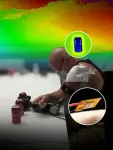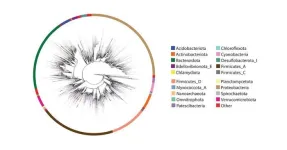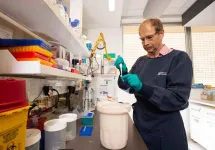(Press-News.org) Johns Hopkins Applied Physics Laboratory (APL) researchers have developed one of the world’s smallest, most intense and fastest refrigeration devices, the wearable thin-film thermoelectric cooler (TFTEC), and teamed with neuroscientists to help amputees perceive a sense of temperature with their phantom limbs. This advancement, one of the first of its kind, enables a useful new capability for a variety of applications, including improved prostheses, haptics for new modalities in augmented reality (AR) and thermally-modulated therapeutics for applications such as pain management. The technology also has a variety of potential industrial and research applications, such as cooling electronics and lasers and energy harvesting in satellites.
TFTEC development at APL started in 2016, when Rama Venkatasubramanian, a semiconductor device engineer and chief technologist for APL’s thermoelectrics research, began developing advanced nano-engineered thermoelectric materials and devices for the Defense Advanced Research Projects Agency (DARPA) MATRIX program. To support MATRIX, APL developed advanced thin-film thermoelectric materials called Controlled Hierarchically Engineered Superlattice Structures (CHESS), to enable an entirely new set of transduction capabilities for several Department of Defense applications, including cooling computer chips and engine components.
Venkatasubramanian’s strides in CHESS thermoelectrics were so significant by the end of 2019 that Bobby Armiger, who supervises APL’s Exploratory Science Branch, wondered if his devices could be used to facilitate temperature sensation in phantom limbs of amputees for improved prostheses. Since 2006, APL had been leading DARPA’s Revolutionizing Prosthetics program, an effort focused on creating a mentally controlled artificial limb that will restore near-natural motor and sensory capability to upper-extremity amputee patients.
“We’ve known that we can stimulate specific parts of someone’s amputated limb to feel sensations of touch and vibration, but no one has been able to create a cooling sensation with the speed, intensity, and efficiency to restore natural thermal perception with a prosthetic system,” Armiger said. “Restoring temperature sensation has practical applications — like identifying a cold beverage — as well as having the potential to improve the emotional embodiment of the prosthetic device, perhaps by feeling the warmth of a loved one’s hand.”
Venkatasubramanian and the thermoelectrics team began collaborating with Armiger and a team of neuroscientists and roboticists as part of a study supported by the Center for Rehabilitation Sciences Research within the Department of Physical Medicine & Rehabilitation (PM&R) at the Uniformed Services University of the Health Sciences (USU), through a subaward from The Henry M. Jackson Foundation for the Advancement of Military Medicine to create a wearable thermoelectric cooler fast and intense enough to match the human body’s ability to rapidly sense temperature changes.
From that, the wearable TFTEC was created.
“Our TFTEC is just a little more than one millimeter thick, weighs only 0.05 grams, similar to a thin adhesive bandage, and can provide intense cooling in less than a second,” said Venkatasubramanian. “It’s also two times more energy efficient than today’s most common thermoelectric devices, and can be readily manufactured using semiconductor tools that are also used for manufacturing light-emitting diodes [LEDs]. It’s an exciting development that could have huge implications for prostheses and haptics applications.”
To test the TFTEC’s efficacy, researchers mapped thermal sensations in the phantom hands of four amputees.
“When someone loses part of a limb, the nerves within the residual limb are still there, which can lead to the ‘phantom’ limb sensation,” said Luke Osborn, a neuroengineering researcher who leads much of APL’s noninvasive nerve simulation work. “You can place electrodes on different parts of an amputee’s upper arm where those nerves have regrown and stimulate sensation — typically pressure, but in the current case, temperature —and the individual can tell us where in their phantom hand they feel those sensations.”
Nature Biomedical Engineering recently published results from APL’s extensive TFTEC research for such sensory applications, which included lab-scale characterization, trials with amputees and a real-life demonstration of the approach. The study notes that the TFTEC elicited cooling sensations in the phantom limbs of all participants during a cold detection task, whereas traditional thermoelectric technology only did so in half of them — and the TFTEC did so eight times faster and with three times the intensity. Additionally, TFTEC used half the energy compared to current thermoelectric devices.
“We found that the TFTEC device was significantly better at creating faster and more intense cooling sensations compared to traditional devices, even though the target temperature was the same,” said Osborn. “And that helped participants make faster decisions and observations.”
The stimulation sites on test participants remained the same over 48 weeks of testing, suggesting that the technology could enable users to feel temperature in their missing hands for years. This temporal stability along with a wearable noninvasive procedure are attractive for adoption to real-world use.
“When we started our work in March 2020, we realized that within just a couple of trials we could stimulate the phantom limbs of an amputee,” said Venkatasubramanian. “We heard participants say, ‘Yes, I felt an immediate cold feeling here and a tingle there.’”
The APL team continued to perfect its approach through testing on several individuals with amputation along with those with an intact limb. “These are the developments we dream of as scientists,” Venkatasubramanian continued. “We spend years in the lab, and to see our technology have an impact on someone’s quality of life, like an amputee to perceive the natural thermal world, is incredibly satisfying.”
Capable of generating realistic and informative thermal signals for human perception — at a fraction of the energy and size compared to today’s cooling technologies — the devices’ low-profile, high-speed, and lightweight nature make them suitable for skin surface applications without hindrances that could affect movement.
“It has been great to see the translation of this APL-developed thermoelectric technology into the healthcare domain through this first-of-kind demonstration in an amputee,” said David Drewry, a biomedical engineer and program manager within APL’s National Health Mission Area. “We look forward to expanding the results in more robust clinical trials and integrating the device into other wearable form factors that can be readily deployed to individuals in need of sensory restoration or haptic feedback.”
Katy Carneal, a biomedical engineer and assistant program manager a biomedical engineer and assistant program manager who leads innovative health-related research at APL sees a vast set of future applications for the miniaturized thermoelectric technology. “There are so many ways that pressure and temperature sensations impact the human body,” said Carneal. “In addition to improving quality of life for amputees, we’ve opened a lot of research doors that can help us study and find new treatments for neuromuscular diseases or chronic pain.”
Dr. Paul Pasquina, the chair of PM&R at USU, echoed that enthusiasm while praising the work of the APL team. “What a privilege it is to work with such expert engineers to come up with solutions to help real-world patients, including our wounded warriors with limb loss,” he said.
APL is uniquely qualified to advance the art-of-the-possible for novel health applications by exploring this intersection of materials science and electronic device engineering with biology and neuroscience. In addition to the Revolutionizing Prosthetics program, APL is making significant advances in neural interface research, improving genomics tools and monitoring physical fatigue to prevent warfighter injuries among many other advancements in the National Health Mission Area.
END
Johns Hopkins Applied Physics Laboratory restores cold sensation in amputees’ phantom limbs
2023-07-27
ELSE PRESS RELEASES FROM THIS DATE:
New resource harmonizes 16S and shotgun sequencing data for microbiome research
2023-07-27
Two leading sequencing techniques are no longer at odds, thanks to an international effort led by scientists at University of California San Diego. In a study published July 27, 2023 in Nature Biotechnology, the researchers debuted a new reference database called Greengenes2, which makes it possible to compare and combine microbiome data derived from either 16S ribosomal RNA gene amplicon (16S) or shotgun metagenomics sequencing techniques.
“This is a significant moment in microbiome research, as we’ve effectively rescued over a decade’s worth of 16S data that might have otherwise become obsolete in the modern world ...
Preventing weight gain: Yo-yo no-go zones for Australians
2023-07-27
There’s no doubt that Aussies love a good celebration. We’re all in when it comes to the weekend, and most of us can’t go past a Christmas celebration without a little bit of overindulging. But all this comes at a cost, and it’s taking a massive toll on our waistline.
Now, a world-first study from the University of South Australia exposes the real weight gains of everyday Australians, in a move to tackle overweight and obesity.
Funded by the NHMRC, and published in JAMA Open Network today, the study explored how weight changes across a 12-month period, finding that weight fluctuated throughout the year.
Specifically, ...
Closing cancer cell’s escape route
2023-07-27
Chemotherapy and radiotherapy aim to destroy cancer cells by inducing DNA double-strand breaks – damage that, once inflicted, usually causes the cells to die. But damage to a cell’s genetic material also activates a signaling pathway called IKK/NF-κB that helps prevent cell death, thus limiting the success of these treatments in patients.
NF-κB is a family of gene regulators that controls a wide variety of cellular processes – from immune responses to embryonic development – and is activated by the enzyme complex ...
Fiber-infused ink enables 3D-printed heart muscle to beat
2023-07-27
Over the last decade, advances in 3D printing have unlocked new possibilities for bioengineers to build heart tissues and structures. Their goals include creating better in vitro platforms for discovering new therapeutics for heart disease, the leading cause of death in the United States, responsible for about one in every five deaths nationally, and using 3D-printed cardiac tissues to evaluate which treatments might work best in individual patients. A more distant aim is to fabricate implantable tissues that can heal or replace faulty or diseased structures inside a patient’s heart.
In a paper published in Nature Materials, researchers ...
New technology promises rapid and reliable development of new diagnostic tests
2023-07-27
QUT researchers have developed a new approach for designing molecular ON-OFF switches based on proteins which can be used in a multitude of biotechnological, biomedical and bioengineering applications.
The research team demonstrated that this novel approach allows them to design and build faster and more accurate diagnostic tests for detecting diseases, monitoring water quality and detecting environmental pollutants.
Professor Kirill Alexandrov, of the QUT School of Biology and Environmental ...
Jinghui Zhang, Ph.D., elected Fellow of the International Society for Computational Biology
2023-07-27
(Memphis, Tenn. – July 27, 2023) St. Jude Children’s Research Hospital proudly announces that Jinghui Zhang, Ph.D., Member of the Department of Computational Biology, has been elected as a Fellow of the International Society for Computational Biology.
Zhang is one of 15 scientists given this distinction in 2023. She’s being honored for the development and application of innovative computational methods, discovering novel targets and accelerating research and genomic data sharing to advance the diagnosis, treatment and surveillance of pediatric cancers and survivors.
“I ...
Motivation and pleasure deficits play important role in social functioning across psychiatric disorders
2023-07-27
Dr. Raymond Chan's team from the Institute of Psychology of the Chinese Academy of Sciences and his collaborators have recently shown that amotivation and anhedonia, rather than expressive dysfunction, play a crucial role in determining the social functioning of schizophrenia patients.
The study was published in Nature Mental Health.
Negative symptoms refer to the loss of normal functioning, including anhedonia, avolition, alogia, asociality, and affective blunting, and have been shown to be the most important predictors ...
Storing fat at the waist may NOT up diabetes risk, surprise findings indicate
2023-07-27
Conventional wisdom holds that storing fat around your belly puts you at increased risk for type 2 diabetes. But surprising new findings from the University of Virginia School of Medicine suggest that naturally occurring variations in our genes can lead some people to store fat at the waist but also protect them from diabetes.
The unexpected discovery provides a more nuanced view of the role of obesity in diabetes and related health conditions. It also could pave the way for more personalized medicine – treatments tailored to the individual. ...
Using cosmic weather to study which worlds could support life
2023-07-27
COLUMBUS, Ohio – As the next generation of giant, high-powered observatories begin to come online, a new study suggests that their instruments may offer scientists an unparalleled opportunity to discern what weather may be like on far-away exoplanets.
Dubbed the extremely large telescopes (ELTs), these observatories, which include the Extremely Large Telescope (ELT), the Giant Magellan Telescope (GMT), and the Thirty Meter Telescope (TMT), will be some of the largest ground-based telescopes ever built, and their instruments are expected to exceed ...
Introducing the 'Polyphenols Innovation Network': Catalyzing advances in polyphenols research
2023-07-27
Malta – We are delighted to announce the launch of the Polyphenols Innovation Network (PIN), a pioneering initiative designed to accelerate progress in the field of polyphenols research by fostering a collaborative and innovative environment.
Under the banner of PIN, our mission is to assemble a diverse team of multidisciplinary experts, committed to advancing the frontiers of polyphenols research, applications, and innovation.
Projects of PIN:
Three pioneering projects have been earmarked for initiation under the auspices ...






